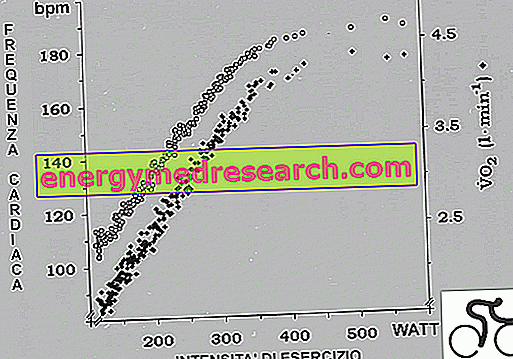Lactic acid threshold: definition and test to measure it
Lactacid threshold means the moment of physical performance, or the graphical point of a test, in which the anaerobic lactacid metabolism intervenes massively in support of the aerobic one; this condition results in a lactate production higher than the muscular and systemic disposal capacity (> 3.9 mmol / l).
The lactic acid threshold is also better defined as an anaerobic threshold.
The lactic acid threshold correlates to the ability to sustain a prolonged exercise; the effort practiced above or below the threshold includes an essential difference in metabolic effort. Below the lactate threshold, the muscles involved in the performance of the athletic gesture maintain a constant aerobic activation and a persistent lactic acid anaerobic commitment BUT LOCKING.
To clarify the progression of lactic acid during an incremental effort it is essential to have an eye on one or two graphs showing cardiac activity and blood lactate concentration. These values can be obtained by performing:
- Blood sampling during exercise
- Heart rate detection during activity (even better by performing a Conconi test)

Image of a Conconi test in which it is possible to notice the classical deflection of the straight line that relates heart rate and exercise intensity. At the point of deflection the lactic threshold is identified.
Unfortunately, in many subjects the trend of heart rate according to the intensity of exercise does not allow to identify a point of deflection; for this reason, many exercise physiologists prefer to measure the amount of lactate in the blood at predetermined time intervals during an incremental test similar to that expected from the Conconi test (see image below).

Why is it important to determine the lactic threshold?
Detecting the lactic acid threshold is of fundamental importance both in the athlete and in the subject who practices sports therapy (against hypertension, diabetes, obesity, dyslipidemia, metabolic syndrome, etc.).
- In the endurance athlete (long distance races) the lactic acid threshold represents the maximum limit beyond which it is NOT possible to increase the effort WITHOUT the lactate accumulating and negatively affecting the muscular contraction; running, swimming, pedaling, rowing, paddling in the lactate threshold allows you to fully train your aerobic metabolism by raising this capacity and bringing it as close as possible to the maximum oxygen consumption or aerobic power (PA: measurable parameter through the detection of VO2max - consumption of ml O 2 / minute). This physiological modification leads to a direct performance increase to which, however, a second limiting factor correlates, aerobic fitness; to be clear, the effort in the lactacid threshold involves the energetic combustion of a mixture mainly composed of muscle glycogen, which is contained in the myofibrils in LIMITED quantities. The "AUTONOMY" performance in the lactic acid threshold depends on the consistency of the glycogen stocks and on the potential of disposal of the lactic acid produced (almost 4 mmol / l), and is defined as AEROBIC CAPACITY. Furthermore, by raising the lactic threshold, the aerobic threshold (SAE) is also increased, which represents the ideal intensity level (about 2mmol / l of lactic acid) in races that reach two hours in duration (very long cross-country races) and provides for the combustion of a mixture containing a percentage of fatty acids higher than the lactic threshold; carrying out an activity in SAE does not require a particular ability to dispose of lactate and the duration of the effort depends above all on the importance of stocks of muscle glycogen, hydration and hydrosaline homeostasis. This capacity is better defined AEROBIC RESISTANCE. As for the importance of the lactic acid threshold in the middle distance, it seems to play a less important role than the long and very long bottom; in fact, although it has been ascertained that the aerobic metabolism comes into play even in the last moments of a relatively short race such as the 400m level, the development of a higher lactic acid threshold MUST leave room for the search for the maximum LACTID POWER. However, the more the middle distance is approaching the times and the distances of the bottom, the greater the importance of the lactic acid threshold.
- In the subject who practices sports therapy or simply physical activity, determining the lactic acid threshold is very important but also VERY COMPLEX. If it is a simple routine for an athlete to perform an incremental test, some complications could occur for an ordinary person:
- NOT SUITABLE for the practice of very high intensity exercises (cardiac, articular, respiratory compromises, etc.)
- Insufficient remission or motivation
- Insufficient training level
As easy as it may seem, conducting an incremental test does not always lead to obvious results like those shown in the charts of elite athletes. Often, the level of training of a sedentary subject is so low as to involve the lactic acid metabolism even at very low intensity, making it impossible to identify the lactic acid and SAE threshold points.
To make the idea better, it is possible to define that:
- if for an elite athlete, the lactic acid threshold is around 85% of the VO2max (almost the same as the maximum heart rate), for a sedentary the accumulation of lactic acid> 3.9 mmol / l may occur at a level of exercise equal to 50-55% of VO2max.
Performing an incremental test (such as the Conconi test) on a sedentary subject, in addition to being risky for excessive cardiac involvement, would in most cases provide confusing and insignificant values. In a similar situation it is much more correct to proceed with the TRADITIONALLY GRADUAL start-up to the exercise, until a good physical shape is reached. This could be identified in the ability to carry out extended physical activity for 45-60 'at least 60-70% of the maximum heart rate (FCmax) ; such a process could last even a couple of years.
Contraindications in training below and / or above the lactic threshold
Aware of the fact that training must be established on the basis of specific objectives, we remind you that training in the lactate threshold determines an enhancement of the aerobic metabolism with relative increase in the speed of competition thanks to some anatomical, functional and enzymatic modifications.
In this regard we recall that, if it is true that for an endurance athlete to train too low lactate threshold determines, not only a stall of the same, but even a lowering of the deflection value (VD - synonymous with lactate threshold), it is also true that, as anticipated, for a middle-distance runner (especially a short one) engaging too much in raising the lactic acid threshold could prove to be an unsuccessful choice.
We conclude by recalling that the lactacid threshold training is established in relation to the heart rate and is easily manageable with intensities ranging between 3% below and 3% above the VD, applicable to repeated tables, changes in rhythm or prolonged distances.



